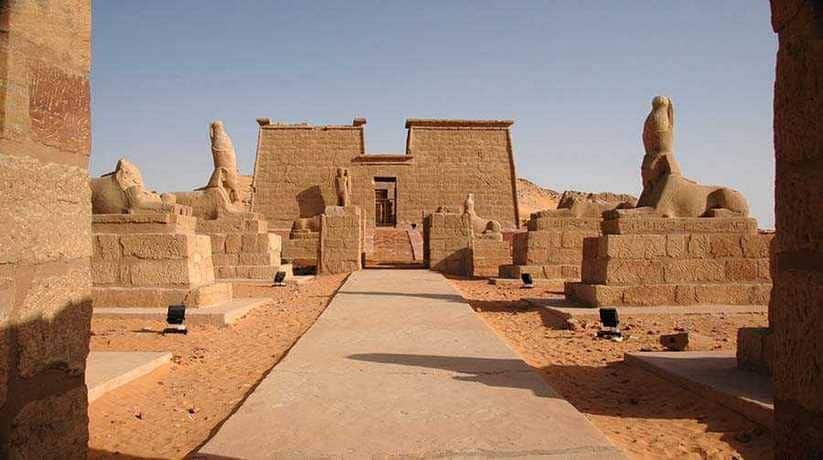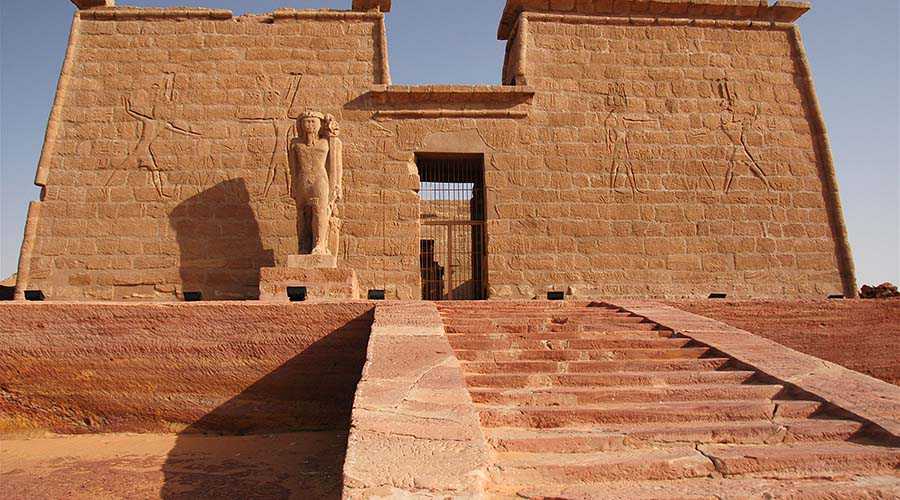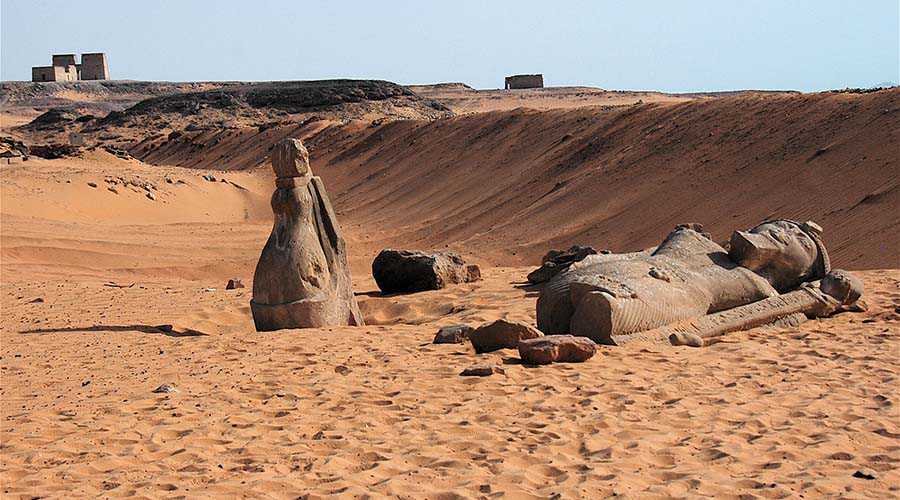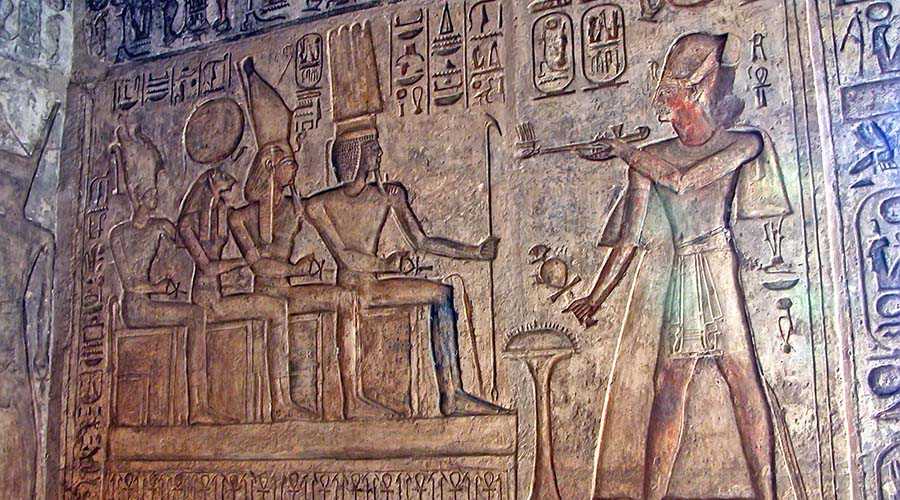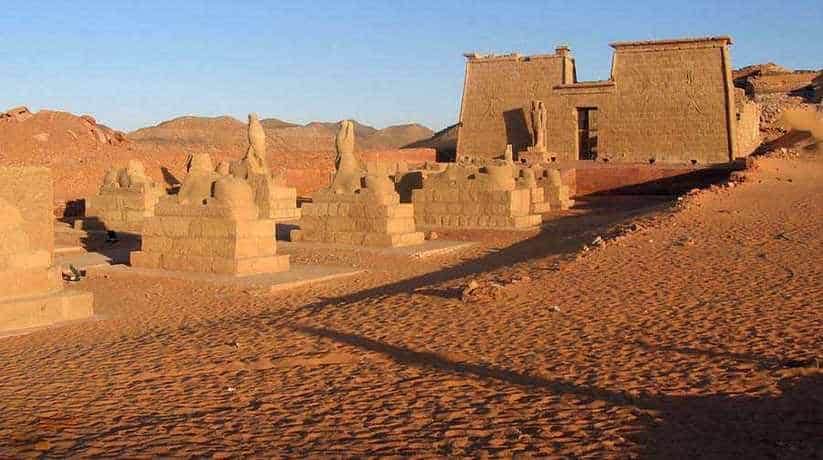Wadi Es Sebua temple Aswan Egypt tours, prices, booking
Wadi Es Sebua temple Aswan located about 140 kilometers south of the Aswan High Dam. It located in ancient Nubia on the west bank of the Nile. In fact, two temples built during the New Kingdom’s 18th and 19th Dynasties. One of these temples built by Ramses II and it now referred to as the Temple of Wadi es-Sebua. In fact, it known as the “House of Amun”. Wadi Es Sebua temple Aswan salvaged in 1964 and moved to a new elevated site. The site is several kilometers to the northwest. It was after the construction of Aswan High Dam. The second temple which built by Amenhotep III, buried beneath the waters of Lake Nasser. However, five stela from this temple are in the Aswan Museum.
Wadi Es Sebua temple and the other temple were a part free standing and a part of speos. A section of the temples hewn from the surrounding rock. The temple which built by Amenhotep III dedicated to the Nuibian form of the God Horus. It also dedicated later to Amun during the time of Ramses II. In fact, this temple damaged during the Amarna Period, but later restored by Ramses II. The temple which built by Ramses II, utilized at least some Libyan captives. It was sometime around his 44th year as king. In fact, the temple was the third speos style temple that Ramses II built in Nubia. Moreover, it is the most famous of which is of course at Abu Simbel. The temple sphinx-lined approach in the two forecourts. They lead to the initial stairway which provides the name of this area.
Further details about Wadi Es Sebua temple Aswan:
In fact, the area known as the Valley of the Lions (Arabic Wadi al Sebua). The temple has an entire complex. The entire complex proceeds the rock hewn chambers. Moreover, it enclosed within a huge brick wall over a meter thick. It is on a rectangular plan and measures 35 by 80 meters. Furthermore, it is with buttresses on the north and south external sides. Wadi Es Sebua temple Aswan had a raw brick pylon gateway. In fact, it now lost. It flanked by a statue of Ramses II and a human-headed (Ramses II) sphinx on either side. It led to the first forecourt. Within this forecourt, a central alley bordered by two large human headed sphinxes. At the rear of this courtyard of the temple, another thick pylon stood.
In fact, it also made of brick and fronted by statues of Ramses II. It also lost. In the second courtyard, another alley led two sphinxes on either side with the heads of falcons. They protected, between their legs, statuettes of Ramses II wearing the nemes headdress. An inscription on their bases refers to Ramses II’s sed-festival. The inscription also expresses his desire for a long life. To the south of this, there is a small courtyard with an altar which dedicated to Re-Horakhty. After the second courtyard, there was a stairway which leads up to a high terrace of the section. In fact, it built in stone and which abutted a cliff. It was before the temple’s relocation. This part of Wadi Es Sebua temple is from stone and hewn from the cliff. In fact, it is like the temple at Gerf Hussein.
More details about Wadi Es Sebua temple Aswan:
This part corresponds to the typical tripartite cult temple. It is with a court, a hypo-style hall and sanctuaries. A stone pylon measuring 24.5 meters wide and 20 meters tall abutted by four colossi of Ramses II. Moreover, it is some six meters high on one meter bases and forms the facade to the court beyond. In fact, this pylon has no recesses for the flagstaffs which found in temples. Wadi Es Sebua temple has reliefs on the pylon which depict Ramses II. It is while he sacrifices to Amun on the south side, and to Re-Horakhty on the north. This pylon remains and there is also one colossal statue of Ramses II which left on the southern side. This is a typical striding statue of the king with the left food forward. By his side stands a small statue of a queen who may represent his eldest daughter.
In fact, she later became his wife. Another statue stood to the north now lies in the sand. It depicts Ramses II with a standard surmounted by the head of a falcon. Beyond, the so called “feast court” is almost square and measures 19.8 by 20.6 meters. It bordered by two porticoes with five pillars. Moreover, it is with engaged standing Osiris style statues of Ramses II. To the south is a slaughter court that lies between the wall of the court and the enclosure wall. On the walls of this court depicted one of Ramses II’s well known processions of his children. It includes 51 princes and 63 princesses, together with their names. Other scenes present Ramses II before various deities. At the rear of the “feast court”, a second stairway leads up to the second terrace. In fact, it runs along the rock hewn part of the temple.
Further details about Wadi Es Sebua temple Aswan:
Beyond there is another square and twelve pillars. It so called “hall of appearance”. The bases of the pillars cut from the living rock. The pillars on either side of the central alley have Osiride statues of the pharaoh abutted to them. In fact, there are various scenes within this chamber. They depict the pharaoh together with many gods and goddesses. They include Shu, Nekhbit, Tefnut and Hathor. Wadi Es Sebua temple has another relief shows the god Ptah. In fact, he promises many sed-festivals to Ramses II. After the pillared hall, there a so called transverse “chamber of offering”. In fact, it flanked by a room at either end. Beyond it, is the main sanctuary in the center which flanked by two narrower chapels. The center chamber is a bark chapel.
In fact, it once contained the sacred bark and illustrated with the prow of a falcon on the northern wall. There are also other scenes which represent Ramses II who embraced by Mut and Hathor. He offers food to Amun-Re. At the rear of the central chamber is a niche. In fact, it once contained a statuary group. The group consists of Amun-Re, Ramses II and Re-Horakhty. The entrance to the niche decorated with an image of Ramses II while he worships the gods within. However, this ancient theme changed by the early Christians. In fact, they converted the temple into a church. It now shows Ramses II offering to St. Peter instead.


